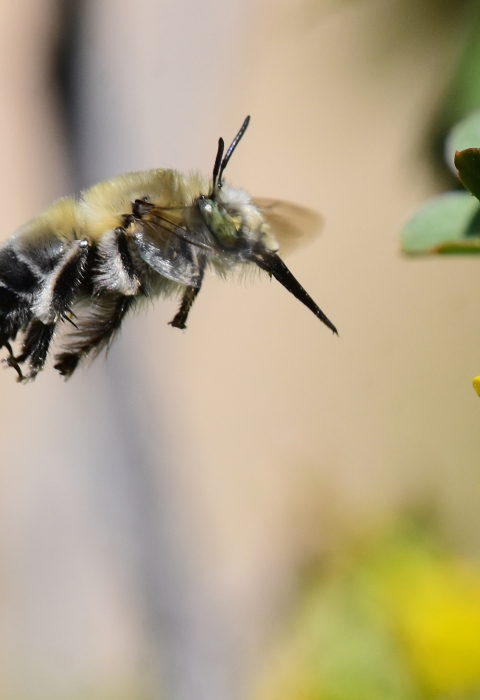As spring arrives with warmer temperatures and plants starting to grow, many pollinators wake up from their restful state and are ready to begin the next phase of their life. We at the U.S. Fish and Wildlife Service recognize the value of native plants that benefit pollinators throughout their entire life cycle. Having early season native plants in your yard, community garden or park gives pollinators a good start to their buzzy season.
Native plants are particularly important for pollinators, because they commonly evolved in tandem across specific geographies and microclimates to have mutually beneficial relationships. Native plants provide pollinators with healthier food, typically at the right time during different phases of their life cycle and shelter. You benefit from native plants too, by conserving water and requiring less maintenance.
Pollinators fly, walk or even wiggle in search of plants to feed on, lay eggs or rest. This movement is closely tied with new growth of early season native plants such as monarch butterflies that require milkweed for completing its life cycle. As monarchs move away from their overwintering sites on the California coast or central Mexico, fertilized female butterflies search for milkweed to lay eggs and to feed the next generation of hungry caterpillars after hatching. She may lay as many as 300 eggs on milkweed to start the first generation of the year. With more than 90 native species of milkweed across North America, she has a lot to choose from. This diversity of milkweed is great and most of the contiguous lower 48 states have at least one native milkweed species. This is one reason monarchs are found throughout much of the United States.
The importance of early season nectar and host plants
Like monarch butterflies, many species of pollinators are in decline. One common challenge they face is habitat loss. Pollinators may require fueling up on nectar resources to overwinter or find places to rest in the winter. In the spring, they may require nectar resources to migrate, mate or change into their adult phase of their life cycle. Some require particular plants to conduct these activities.
Many native plants that flower are hardy and grow in various places. Common places to find these plants include prairies, meadows, livestock pastures, agricultural margins, roadsides, wetland areas, mountain foothills, sandy areas and gardens. Though pollinators do use sites with very few plants, more plants in more places can support more different types of pollinators. Fewer plants may result in higher per-plant pollinator density, which can increase the risk of spreading disease and can result in competition.
One main goal at the U.S. Fish and Wildlife Service is to create more high-quality pollinator habitat. By creating habitat, we are protecting and providing early season native flowering plants, like milkweed in the monarch's early breeding zones of Texas, Oklahoma and California. Milkweed species in these states typically sprout in the months of March and April. They are of particular interest because the leaves and stems are available to monarchs for egg laying and caterpillar feeding. These early milkweed plants are likely a critical piece to monarch survival because they provide a stepping stone during spring migration north to breed on later-emerging milkweed plants.
How you can help pollinators
Plant a pollinator garden using native plants. Know what plants are native to your region that benefit pollinators, especially early and late season flowering plants. When buying native plants at your local garden center, look for the complete species name on the plant label and also check the plant itself. If you find mislabeled pots or not any native plants, let the staff and manager know. They usually are not aware and want to know what their customers want to purchase.







